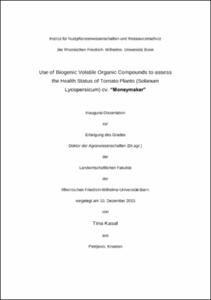Use of Biogenic Volatile Organic Compounds to assess the Health Status of Tomato Plants (Solanum Lycopersicum) cv. “Moneymaker”

Use of Biogenic Volatile Organic Compounds to assess the Health Status of Tomato Plants (Solanum Lycopersicum) cv. “Moneymaker”

| dc.contributor.advisor | Goldbach, Heiner E. | |
| dc.contributor.author | Kasal, Tina | |
| dc.date.accessioned | 2020-04-21T12:49:25Z | |
| dc.date.available | 2020-04-21T12:49:25Z | |
| dc.date.issued | 16.02.2016 | |
| dc.identifier.uri | https://hdl.handle.net/20.500.11811/6595 | |
| dc.description.abstract | The goal of the present study is to test if tomato biogenic volatile organic compounds (BVOC) can be used as an early stress indicator. In this study, influences of drought and biotic stresses on BVOC emissions were investigated under controlled conditions. The BVOC under study were constitutively emitted monoterpenes (MT), stress-induced terpenoids (E,E)-4,8,12-trimethyltrideca-1,3,7,11-tetraene (TMTT), (E)-β-ocimene, α-copaene as well as stress induced green leaf volatiles (GLV), hexenyl derivatives (HexD) and methyl salicylate (MeSA). Under mild drought stress, emissions of TMTT, (E)-β-ocimene and HexD increased, but these increases were not attributed directly to drought. Under severe drought, the same emissions decreased almost to zero as a direct consequence of applied drought and transpiration reduction, while emissions of constitutive MT increased due to leaf wilting and trichome damage. The final stage of drought caused membrane damage what resulted in bursts of GLV emissions. None of these effects is restricted to drought. The second part of the study focuses on BVOC emissions from tomato plants exposed to Botrytis cinerea, Oidium neolycopersici, Myzus persicae and Trialeurodes vaporariorum. This study shows that four de-novo emissions (α-copaene, (E)-β-ocimene, MeSA and HexD) were associated directly to plants reaction to the biotic stresses. Experimental results indicate that Botrytis cinerea infected plants had predominantly jasmonic pathway activated and Myzus persicae / Trialeurodes vaporariorum infested plants had predominantly salicylic pathway activated. In plants infected with i, BVOC emission were very low hampering identification of a pathway activated by the stress. Compounds induced by biotic stress were studied to assess the usability of such emissions for biotic stress detection in greenhouses. Four target compounds were chosen for biotic stress detection in tomato greenhouses:a-copaene, MeSA, HexD and GLV. | en |
| dc.language.iso | eng | |
| dc.rights | In Copyright | |
| dc.rights.uri | http://rightsstatements.org/vocab/InC/1.0/ | |
| dc.subject.ddc | 570 Biowissenschaften, Biologie | |
| dc.title | Use of Biogenic Volatile Organic Compounds to assess the Health Status of Tomato Plants (Solanum Lycopersicum) cv. “Moneymaker” | |
| dc.type | Dissertation oder Habilitation | |
| dc.publisher.name | Universitäts- und Landesbibliothek Bonn | |
| dc.publisher.location | Bonn | |
| dc.rights.accessRights | openAccess | |
| dc.identifier.urn | https://nbn-resolving.org/urn:nbn:de:hbz:5n-42591 | |
| ulbbn.pubtype | Erstveröffentlichung | |
| ulbbnediss.affiliation.name | Rheinische Friedrich-Wilhelms-Universität Bonn | |
| ulbbnediss.affiliation.location | Bonn | |
| ulbbnediss.thesis.level | Dissertation | |
| ulbbnediss.dissID | 4259 | |
| ulbbnediss.date.accepted | 10.12.2015 | |
| ulbbnediss.institute | Landwirtschaftliche Fakultät : Institut für Nutzpflanzenwissenschaften und Ressourcenschutz (INRES) | |
| ulbbnediss.fakultaet | Landwirtschaftliche Fakultät | |
| dc.contributor.coReferee | Noga, Georg |
Dateien zu dieser Ressource
Das Dokument erscheint in:
-
E-Dissertationen (1128)




